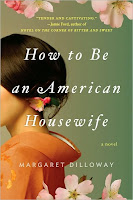 This week’s pick comes courtesy of my book club, a group of dynamic women that have met for over six years and actually talk about the books we read. Oh sure we fit in the offshoots and the tangents where art imitates life, or catch up on work, lack of work, significant others, or a lack of others that are truly significant, and then we find our way back to the book, for better or worse. This month, it was for better, because not only was HOW TO BE AN AMERICAN HOUSEWIFE by Margaret Dilloway a great read, but we also got to talk to the author during our monthly ritual of dining and dishing.
This week’s pick comes courtesy of my book club, a group of dynamic women that have met for over six years and actually talk about the books we read. Oh sure we fit in the offshoots and the tangents where art imitates life, or catch up on work, lack of work, significant others, or a lack of others that are truly significant, and then we find our way back to the book, for better or worse. This month, it was for better, because not only was HOW TO BE AN AMERICAN HOUSEWIFE by Margaret Dilloway a great read, but we also got to talk to the author during our monthly ritual of dining and dishing.
Week 44: How to Be an American Housewife – Margaret Dilloway
HOW TO BE AN AMERICAN HOUSEWIFE shares the story of a mother and daughter, clashing the way mother’s and daughters can, but it also adds the element of a culture clash. Shoko, the mother, and the narrator of the first half of the book is a Japanese woman who marries an American serviceman to escape her war torn country. Leaving behind the mother and father who encouraged her and a brother from whom she is estranged, she sets up house in California and struggles to fit in with other servicemember wives. Her story begins in the present day, a time when Shoko’s health is failing her and she needs the help of her now-grown daughter Sue.
Sue, a first-generation Japanese-American and the focus of the book’s second half, is a single mother always in search of her mother’s approval while just going through the motions in a job and life that lacks both passion and direction. Struggling to connect with her mother, it’s this very personal request that brings the two closer and bridges years of disconnect between the two.
One of the strengths of Dilloway’s writing is the authentic feel she brings to the the dialogue between Shoko and Sue. As I reader I could experience the tension between Shoko and Sue, so common between mothers and daughters, and the moments of connection and happiness. The book’s authenticity is also driven by Dalloway’s own experiences with her Japanese mother and the dialect she brought to Shoko’s character.
My only struggle with the book was one characters rapid development, which seemed a bit too fast for all that was going on in the story. Certainly not a deal breaker, all of the other elements made for an enjoyable read, lively discussion and interesting perspectives from Dilloway herself during our book club conversation. Her favorite book is Little Women and she enjoys books the depict the realist struggles people experience, while keeping faith and hope alive despite the circumstances. I think the same can be said for HOW TO BE AN AMERICAN HOUSEWIFE.
Dilloway generously makes herself available for book club discussions, just check out her blog to find out how.
Rating: 4 stars
Pages: 288
Genre: Fiction

Glad you enjoyed it, too! I also found that I wanted to learn more about some of the supporting characters…I think that is a good sign that our interest was piqued. I really enjoyed the book and thought it was awesome that the author spoke with us – and was even re-inspired to go buy some Japanese food I haven’t had in a while!
I was so jealous when you told me about the author conversation! This sounds like an interesting read.